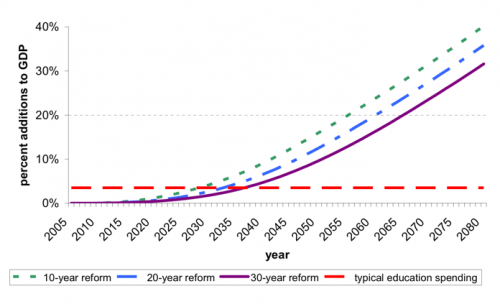How to Assist Online Instructors in K-12 Education in China 如何辅助中国K-12学校教师实施在线教育
How to Assist Online Instructors in K-12 Education in China
Yupei Duan
Curriculum Center, Future Leadership Academy, Hai Nan, China
School of Information and Learning Technology, University of Missouri, Missouri, The USA
December 12, 2020
How to Assist Online Instructors in K-12 Education in China
Background and Significance of the Research
Carliner and Shank (2008) have summarized four key challenges of e-learning: Organizational Barriers, Pedagogical, Technical and Financial Issues. China is faced with most of these issues, together with some unique challenges (Y. Wang et al., 2018a). Teachers are vital component in education. Online teachers have a variety of roles they need to play, such as: evaluator, administrator, technologist, advisor/counselor, researcher, etc. and they should be equipped with multiple competencies (Baran et al., 2011). It is critical to prepare and support teachers for online teaching so that they know what to expect and how to establish their online teacher persona through online pedagogies, and also develop positive attitudes towards online teaching. By incorporating collaborative work groups, community building, and group discussions into professional development programs, and sustaining their continuity, teachers will have an opportunity to participate in communities of practice and transform their teaching by socially constructing their knowledge and practices (King, 2002).
The COVID-19 affected the whole world a lot. It was a test for the online education in different countries and districts. During the pandemic period, educators and students had to rely on online education to continue schoolings. The development of Online education in China has been constrained by a lot of limitations. Zhanyuan Du, Vice Minister of Education of China, has stressed that there are three key tasks for e-learning development in China: “teachers’ and students’ acknowledgement of e-learning, teachers’ capacity for integrating ICT with daily instructions, and production of sufficient quality resources so that teachers can focus on pedagogical design (中国教育信息化要解决三问题 – 信息化动态 – 中国教育信息化网, 2015).” While more teachers in China are equipped with the basic Information and Communication Technology (ICT) knowledge and skills and get more knowledge about e-learning, the situation of China’s online education might be better. Since ICT is the foundation of online education, teachers who have more abilities about ICT, who could understand the value and usability of online education, who might integrate ICT more in their daily instructions, and who have more possibilities to yield higher-quality online education production.
Problem Statement
This study aims to explore the experiences, suggestions and standards for assisting online instructors to present higher-quality online instructions drawing mostly from the USA, and introduces some useful strategies from institutes who have been endeavoring to establish high standard online education from all over the world to China’s K-12 schools. With practice and comparation to make the most suitable one for China.
With collecting data from practices in some volunteer Chinese K-12 schools, the researcher wants to finish the first draft of Chinese K-12 online education standards and design some useful in-service or pre-service trainings for Chinese online instructors.
Purpose of the Study
The researcher will focus on the online education at China’ K-12 school context among the different types of online education. The COVID-19 pandemic has made all stake holders at schools: parents, students, educators and administrators to realize the value of high quality of online education much better. There are a lot of startups and E-giant companies are seizing the profit of online education by inventing new Apps and platforms, and establishing online courses and commercial training programs to the K-12 students in China. There has been so much growth in this market that the government has issued a lot of regulations to control them(Growth of China’s Online Education Industry Spurs New Regulations, 2020) . The fast increase need of high-quality online education from learners are apparent. Yet the supportive standards for evaluating and establishing online education were limited in China. On the other hand. If the students can get high quality online education from their own school with their familiar educators and yield more learning outcomes, why they need to pay extra money out of school? The more expansive thing for the learners is not money but time.
The author could not find formal instructions to assist teachers about how to do high-quality online teaching in Chinese. However, there is a great deal of information in English. What kinds of online teaching standards, teaching strategies suggestions the Chinese online educators need currently? What kinds of online learning tips Chinese learners should be aware of to yield higher online learning outcomes? Is the information workable, effective and efficient? The mixed-methods will be used during the research.
Literature Review
Sources deemed most relevant to the topics were selected for further analysis; preference was made to recent (published during 1999-2020) articles, but older sources were included especially the classical ones which contain impressive points and suggestions. These articles were searched and collected through google scholar and University of Missouri Columbia Libraries, utilizing the following search tactics: K-12, Online Education, Online Teaching, Standards, etc.
Online Education Definition and its Development in China
E-learning, also known as online learning, digital learning or computer-based learning, can be defined as education provided on digital devices that support learning (Clark & Mayer, 2011). The use of Information and Communication Technology (ICT) in education has given rise to diversified pedagogical models and methods, including networked learning, multimedia education, online and open education, and blended learning. In China, the term ‘ICT in Education’ is used interchangeably with the more general term ‘e-learning’ (Y. Wang et al., 2018b). With rapid economic development, China is becoming able to provide better infrastructure and other necessary conditions for schools (e.g. more high-quality computer labs, more learning soft wares and more online learning strategies), E-learning is believed to be a promising approach since it offers students ways to interact with experienced teachers or professors (Q. Wang et al., 2009).
In the first four years after 1996, the growth of online schools (at China) was fast, and the concepts of e-learning and online school were formulated. In the following four-year adjusting stage, the number of online schools decreased remarkably as some investors and managers of over-emphasized on financial gains but while ignoring Standards of web-based education. At the steady stage(2005-2009), managers and teachers have paid more attention to the educational role of online schools. They have developed better understanding and an improved model of cooperation. For example, one of the styles of cooperation is named “Two Instructors Cooperation Model” which means while one instructor teaching virtually, there is the other instructor (teaching assistant) working in the physical classroom to direct the students to dig more from the online instructions.
There are three models of running K12 online schools in China. Some online schools are run by a consortium of the government, or by an enterprise or a school alone. Most online schools in China are supported by private enterprises (Q. Wang et al., 2009). Online education, also known as virtual or cyber schooling, is a formal of distance education that uses the Internet and Computer technologies to connect teachers and students and deliver curriculum. Students may also communicate online with their classmates, students in other schools around the world and experts to whom they might otherwise not have access. Online learning may take the form of a single course for a student who accesses that course while sitting in a physical school, or it may replace the physical school for most or all of a student’s courses (Watson & Gemin, 2010).
K12 Online Education Market in China
In 1996, China’s first primary and secondary education website (online school), 101 online school, was established. Four year later, the Beijing No.4 Online School was built. The education at this time was mainly based on academic education, and the form was mostly based on a single form such as text mail. The interactive form was not strong, mainly based on traditional education methods (Chen et al., 2009). Students and online teachers could only use text to do interactive activities. There were no other choices for the online learners in China who wanted to get higher quality K-12 online instructions. The reasonable online instructions should be more interactive which requires the online instructors to communicate with the learners closely and share the feedback of the learners’ information with their parents frequently. Online instructors need to foster the online learners’ enthusiasm and interest in learning. It is also the online instructors’ duty to embed more technique tools and enhance their skills to improve their online teachings (Hu & Meyen, 2013).
Both Beijing 101 school and Beijing No.4 School are two of best high-schools in Beijing, China. (The author worked at Beijing No.4 School for ten years and has learnt that there were very few requirements for online instructors who taught at Beijing No.4 Online School.) In the past decade, online education market in China changed so fast. More and more companies like “Gen Shei Xue”, “Hao Wei Lai”, “New Oriental School”, etc. have stepped into the K-12 training market to set very high standard and expectations of online education. The parents would prefer to pay more money to buy better online education from these kinds of companies for they keep improving their online teaching strategies (Huang & Hong, 2017).
Quality of Online Teaching
To help China’s K-12 online instructors improve is the first step to get high-quality K-12 online education. Without clear and specific goals, the online instructors will lose themselves and cannot improve their online instructions highly (Baran et al., 2011). There are a lot of mature online teaching standards and suggestions written in English world which might be meaningful for Chinese colleagues.
In 2010, an international quality standard for e‐learning programs – “Open ECBCheck” – was officially released. ECBCheck is an accreditation and quality improvement scheme for e‐learning programs which supports organizations in measuring the success of their programs and allows for continuous improvement though peer collaboration. It was developed through an innovative and participative process involving more than 40 international, regional and national capacity‐development organizations (Open ECBCheck – Quality Improvement Scheme for E-Learning Programmes | GIZ Global Campus 21, n.d.).
In the standards (E-Learning Methodologies – A Guide for Designing and Developing e-Learning Courses, n.d., p. 14), the quality of an e-learning course is enhanced by: (1) Learner-centered content: E-learning curricula should be relevant and specific to learners’ needs, roles and responsibilities in professional life. Skills, knowledge and information should be provided to this end. (2) Granularity: E-learning content should be segmented to facilitate assimilation of new knowledge and to allow flexible scheduling of time for learning. (3) Engaging content: Instructional methods and techniques should be used creatively to develop an engaging and motivating learning experience. (4) Interactivity: Frequent learner interaction is needed to sustain attention and promote learning. (5) Personalization: Self-paced courses should be customizable to reflect learners’ interests and needs; in instructor-led courses, tutors and facilitators should be able to follow the learners’ progress and performance individually.
The third edition of American National Standards for Quality Online Teaching purposely provided the K-12 online and blended learning community with an updated set of openly licensed standards to help evaluate and improve online courses, online teaching and online programs with the contribution from another two documents known collectively as the : American National Standards for Quality Online Programs and American National Standards for Quality Online Courses (Powell et al., n.d. P5). The set of standards served to inform the team, allowing them to make community and research supported updates. Subsequently, author took time to evaluate each standard and found they met the following criteria: measurable, valid, complete, relevant, and specific. Chinese online instructors can check the standards with clear definitions and explanations with examples to transfer to their online teaching actions.
Besides the formal standards which can help online instructors clarify their to-do lists about how to provide appropriate online instructions, the suggestions from some institutes are useful to bring more insights to improve online education for K-12 online instructors, especially during the COVID-19 pandemic spread period. The Danielson Group Remote Teaching Guide (Danielson Group Remote Teaching Guide.Pdf, n.d.) is one of them. Each academic year, the subject teachers in the author’ school will provide at least two class periods to be observed by the members in Academic Department to show their teaching abilities which we name them formal observations. The Academic Department members will use the Framework (Danielson, 2014) for teaching from the Danielson group for assessing subject teachers’ formal observations. The Remote Teaching guide is reflected in Framework for Teaching which shared eight suggestions to online instructors from knowing and valuing the online learners to build responsive learning environment, then to engaging students in learning. The online instructors will find more valuable strategies and tips to miss overwhelming when they conduct online instruction if they delve into deeper with reading and practice the suggestions in the guide.
Trainings for Enhancing Instructors’ Online Teaching Competencies
As online learning grows in K-12, the need to prepare quality online instructors increases (Borup & Evmenova, 2019). There are a lot of barriers the quality online K-12 instructors need to learn to cross. The barriers between the good online K-12 classroom and low efficiency which were listed two decades ago still affect online instructors. The barriers are: Academic, Fiscal, Geographic, Governance, Labor-Management, Legal, Student support, Technical, Cultural (Berge & Mrozowski, 1999). If the teachers did not learn how to face to the barriers when they were in the college, they may get some in-service professional development (PD) programs to help them add this part of competencies. If the PD programs are held fluently, the learners may improve their online teaching skills and knowledge (first-order barriers to change) and nurturing positive attitudes and dispositions (second-order barriers to change) (Borup & Evmenova, 2019). The online PD itself is a good model to show the learners about what is a good online course you need to learn to conduct. There are a lot of difference between face-to-face teaching and online teaching. Barbour (2012) found that the different competencies were required to deliver high quality online teaching. Even the experienced face-to-face teachers might fail to present quality online instructions. The effective PD program will deliver content and assignment proved effective at increasing faculty members’ knowledge and skills, but it was the course delivery and the opportunity to learn as an online student that appeared to most impact faculty members’ attitudes and perceptions of what was possible in online learning environments. In other words, the method was just as important as the message. When designing professional development courses, universities (or other departments) not only need to consider what will be learned but how it will be learned. If courses do not model effective online instruction, they run the risk of increasing faculty members’ skills without improving their practice (Borup & Evmenova, 2019). There are some successful PDs like Borup and Evemenonva’s PD ( 2019) which covers the following topics: (1) course design and development, (2) assessment and feedback, (3) student collaboration, (4) discussions, and (5) presence and support.
Methodology
- Mixed-Method
The mixed-methods will be used. While conducting a bibliometrics focus on online teaching, hybrid teaching, online education standards, etc. The information will be concluded and compared to be selected as suggestions for assisting Chinese K-12 online teachers in their trainings and in-service instructions. Then, some questionnaires will be distributed to online educators, learners and parents to get their feedback about online instructions. The data will be used by qualitative and quantitative methods to test which suggestions or standards will be useful to the online instruction stake holders.
- Research Model
- Brief rationale for the selected approach
With the qualitative and quantitative research, the researcher can collect more divisions of feedbacks about online instructions from online teachers, learners and parents. The aims of the research are figuring out the most reasonable and workable assistance to Chinese K-12 online instructors. We hope to stand on the giant’s shoulder and face to the reality of China’s K-12 online education to compose two documents: Chinese Online Instruction Standards, and Chinese Online Instruction Suggestions, besides that, we will develop PD programs to assist Chinese K-12 online instructors. We wish they are reasonable and meet China’s online instructors’ expectations. Due to the different cultural and historic backgrounds in China and other countries or districts, the experiences from others must be improved to be embedded in Chinese education context. That will be the researcher’s following research aims.
Variables
Independent variables: online teaching standards with using or not; online teaching suggestions with delivering or not; Weather took part in the PD for assisting online instructors developed by researcher.
Dependent variables: Online teachers’ instructional performance scores with using online teaching standards to evaluate; Teachers’ online instruction materials establishing time using before and after training; Teachers’ degree of satisfaction of online instruction before and after training; Online learners’ degree of satisfaction of online education; Parents’ degree of satisfaction with online education.
Sample
170 online learners from primary school, secondary school and high school.
50 online teachers from Future Leadership Academy (a private K-12 school).
100 college students who want to be teachers after graduation at Beijing Normal University.
100 in-service teachers in China K-12 schools.
100 parents whose kids are having online courses.
Data Collection
Qualitative data: Survey, interviews
Quantitative data: Survey, formal observations, data record on learning management system, interviews
Ethical Considerations
Students and parents’ privacy protection. The data from the students and parents will be ONLY used for research and will not be open to others without erasing the names of the students and parents.
Data Analysis
Correlation Analysis using SPSS
Timeline
February, 2021. Preparation period:
In the coming school-wide professional development program, the research proposal will be informed.
February, 2021. Transition period:
the online instructors will be required to having online teaching trainings. The suggestions and strategies will be shared with them as well.
March, 2021. Orientation period:
- The online learners and parents will be delivered online education orientation with introducing more details of online courses and suggestions for online learnings.
- The online instructors will be directed to have online trainings with sharing more online teaching standards.
April-June 2021. Formal online instructions conduction
- Data collection.
- Survey
- Interviews to teachers, students and parents.
July 2021. Data analysis and reaching a conclusion
References
Baran, E., Correia, A.-P., & Thompson, A. (2011). Transforming online teaching practice: Critical analysis of the literature on the roles and competencies of online teachers. Distance Education, 32(3), 421–439. https://doi.org/10.1080/01587919.2011.610293
Barbour, M. k. (2012). Training teachers for a virtual school system: A call to action. In Developing Technology-Rich Teacher Education Programs: Key Issues. IGI Global.
Berge, Z. L., & Mrozowski, S. E. (1999). Barriers to Online Teaching in Elementary, Secondary, and Teacher Education. https://doi.org/10.21432/T2P59B
Borup, J., & Evmenova, A. (2019). The Effectiveness of Professional Development in Overcoming Obstacles to Effective Online Instruction in a College of Education. Online Learning, 23(2), Article 2. https://doi.org/10.24059/olj.v23i2.1468
Carliner, S., & Shank, P. (2008). The e-learning handbook: Past promises, present challenges (MU Ellis Library). Pfeiffer.
Chen, L., Wang, N., & Qiao, A. (2009). K12 online school practice in China. Campus-Wide Information Systems, 26(2), 137–144. https://doi.org/10.1108/10650740910946864
Clark, R. C., & Mayer, R. E. (2011). E-learning and the science of instruction: Proven guidelines for consumers and designers of multimedia learning (MU Online; 3rd ed.). Pfeiffer.
Danielson, C. (2014). The framework for teaching: Evaluation instrument.
Danielson Group Remote Teaching Guide.pdf. (n.d.).
E-learning methodologies—A guide for designing and developing e-learning courses. (n.d.). 141.
Growth of China’s Online Education Industry Spurs New Regulations. (2020, March 12). China Briefing News. https://www.china-briefing.com/news/growth-chinas-online-education-industry-spurs-new-regulations/
Hu, X. C., & Meyen, E. L. (2013). A Comparison of Student and Instructor Preferences for Design and Pedagogy Features in Postsecondary Online Courses. In Curriculum, Learning, and Teaching Advancements in Online Education. IGI Global.
Huang, X., & Hong, W. (2017). Live Streaming Teaching Applied in Real English Classroom. DEStech Transactions on Social Science, Education and Human Science, 0(aems), Article aems. https://doi.org/10.12783/dtssehs/aems2017/8278
King, K. P. (2002). Educational technology professional development as transformative learning opportunities. Computers & Education, 39(3), 283–297. https://doi.org/10.1016/S0360-1315(02)00073-8
Open ECBCheck – Quality improvement scheme for E-Learning programmes | GIZ Global Campus 21. (n.d.). Retrieved October 28, 2020, from https://gc21.giz.de/ibt/var/app/wp342P/1522/index.php/open-ecbcheck/
Powell, A., Oliver, W., Archambault, L., Borup, J., Boyarko, M., Cavanaugh, C., Copeland, R., Day, J., DeRosa-Davis, T., Deschaine, M., Graham, C., Hanson, E., Hernandez, B., Imbrunone, M., Kennedy, K., Consulting, K. K., Kolar-Burden, J., Little, T., Loomis, K., … Online, P. (n.d.). National Standards for Quality Online Teaching. 33.
Wang, Q., Zhu, Z., Chen, L., & Yan, H. (2009). E‐learning in China. Campus-Wide Information Systems, 26(2), 77–81. https://doi.org/10.1108/10650740910946783
Wang, Y., Liu, X., & Zhang, Z. (2018a). An overview of e-learning in China: History, challenges and opportunities. Research in Comparative and International Education, 13(1), 195–210. https://doi.org/10.1177/1745499918763421
Wang, Y., Liu, X., & Zhang, Z. (2018b). An overview of e-learning in China: History, challenges and opportunities. Research in Comparative and International Education, 13(1), 195–210. https://doi.org/10.1177/1745499918763421
Watson, J., & Gemin, B. (n.d.). A Parent’s Guide to Choosing the Right Online Program. 23.
中国教育信息化要解决三问题—信息化动态—中国教育信息化网. (n.d.). Retrieved October 28, 2020, from http://www.ict.edu.cn/news/n2/n20150525_24914.shtml
Read More礼物
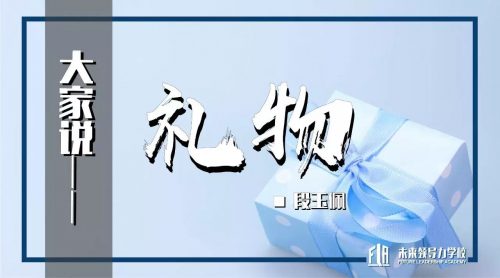
刚刚过去的新春佳节,你收到了怎样的礼物?
礼物,不是一个简单的事物。PRESENT is a special gift.
动画电影《功夫熊猫》中,龟大师(加拉帕戈斯象龟)对阿宝(大熊猫)说了一句话:“昨天是历史,明天是未知,只有今天是个礼物……”很多观众纳闷——逻辑何在?殊不知,英文原作中的龟大师是这样说的:“Yesterday is history, tomorrow is a mystery, and today is a gift…that’s why they call it PRESENT.” 原来,英文单词“Present”有多重含义,作为名词翻译成中文,既有“礼物”的意思,也可用于表达“现在”。
在英文使用者看来,这句台词是很漂亮的双关语,但如果仅用中文理解,可能不仅get不到龟大师的精妙点拨,还会觉得这老龟怎么逻辑牵强,思维混乱?中文世界中,我国宋代朱敦儒写的“领取而今现在”,多多少少表达出了“现在”就是“礼物”的感觉,境界颇可比肩“龟大师”,也难怪朱师别号“岩壑老人”。无论是动画片中龟大师的原型——加拉帕戈斯象龟,还是朱敦儒别号中的“老人”,都给人一种感觉,他们历经沧桑,他们淡然恬静,他们一把年纪……
小时候我听过一个笑话:
一个老人申请当兵。
中士问:多大岁数了?
老人答:六十二岁。
中士说:你应该知道,这个岁数太大了!
老人答:也许当士兵是大了些,可你们难道不需要将军吗?
仅仅走过时间,虚掷年华,即使须发皆白如风清扬,比划两招也还是要露馅的。从小到老是个自然现象,从士兵到将军则是个成长过程,后者是需要“主动不断地在时间流逝中领取而今现在”才可修为而成的。走过很多昨天的人叫“老人”,知道很多答案的人叫“老师”。
为什么当老师?
我是一个年轻的“老”师,从教十年中,我不断被人问起,“你为什么当老师?”我的答案很简单:第一,想让自己变得更好。第二,想让更多人变得更好。
宇宙无边,岁月悠悠,芸芸众生,来了又走,像无风的北京夏日午后,镜面一般凝滞的昆明湖水。我们生活在茫茫宇宙中的一颗蓝色的星球上,地球之于宽广的宇宙,犹如微不足道的一粒粉尘。1977年美国的Eames夫妇制作了一部名为《10的n次方》(Powers of Ten)的影片,镜头从芝加哥的一个湖边开始,视角以10的次方累加,不断扩大,先开始你还可以看到草坪上野餐的人,之后视角持续以10的次方扩大,当扩大到10的24次方时,地球、太阳系、银河系全都变成了微不足道的“粉尘”。
影片的视角虽然放大到这里就暂停了,可是我们的宇宙其实正在加速膨胀呢……还是让我们回到地球上来吧。
“在一块灰暗的石灰岩上,哪怕是有一点微弱的闪光也就足够了。你屏住呼吸,脉搏加快,眼睛闪亮,用锤子轻轻一敲,石灰岩便裂开了——于是就在你的眼前,一个闪亮的贝壳盘绕在岩石上。它与现今存在的海洋贝壳相像,但它可能是1.5亿年以前,甚或是更遥远的5亿年前的海洋贝壳。告诉你一件千真万确的事——你发现的这个贝壳,是第一次被人类的眼睛看到……正是这种刺激吸引着一代又一代的孩子,在悬崖和采石场间攀爬,在海岸和砾石坑中寻觅,引导着他们踏上漫漫发现之旅的,是追寻这个星球,以及生存于星球之上的众生的过去……”
大卫.爱登堡爵士(Sir David Attenborough)在《探寻化石之旅》(Travels with the Fossil Hunters)一书的序言里,对于化石探索过程中的兴奋心情的描述跃然纸上。兴奋如此为哪般?因为触摸化石,即是触摸到了亿万年间的沧桑……人类的历史到底有多长?如果把地球46亿年的演化史比做我们现在的一个昼夜,即24小时,那么人类从出现到今天,则只持续了这一天中的最后半分钟!想象一下吧,到了23时59分30秒,地球上才出现了我们的猿人祖先。人生一世,不过百年,相对于整个地球的46亿年历史和宇宙的138亿年历史,人生,是多么微不足道的一瞬间?我曾在野外考察中,手中摩挲着一块刚刚采到的哺乳动物牙齿的化石长久发呆,感慨着:
谁的眼神可以穿越亿万年
看沧海变桑田
生命是地球最最美丽的赞叹
却只用了一瞬间
凯恩斯(John Maynard Keynes)说过:“长远来看,我们都会死”。你选择怎样对待自己,这只有一次的人生旅程?我的选择是,尽可能充分地参与到这倒计时的生命之旅中。如何充分参与?让自己变得更好,让更多的人变得更好。我当了10年老师,浅尝了这两点。唐代韩愈作《师说》,谓“师者,所以传道授业解惑者也”。在我看来,“传道授业”让我变得更好了,我通过“解惑”让更多的人变得更好了。
想要更好地“传道授业”,就要对所要传授的内容做到精通,为了做到精通,就需要刻意练习。有一次,同组的卓老师问我,你喜欢做公开课吗?我说不是全喜欢,她问,那你为什么做这么多公开课?我说,一是可以逼着我练习,二是虽然公开课的准备很难受,不喜欢,但上完之后的成就感很强,很幸福。三是上公开课的时候,别人给你录像,记录下来你现在玉树临风的青春风采,多年之后拿出来看看,多好的事儿啊?把”现在的自己“记录下来,就是送给”未来自己”的礼物啊。Present is a special gift to the future.
能够为学生传道授业解惑的老师,在韩愈看来是合格的,但我觉得在这之上,师者还要做更高的登攀——教会学生“质疑”。“解惑”是老师解开学生心中的谜团,而“质疑”则是老师让学生主动在心中造成谜团。解惑是学习的结束,往往豁然开朗;质疑是研究的起点,常常曲径通幽。在我看来,当学生能够提出更好的问题,对所学内容进行质疑时,会对当前的学习内容,有更深刻的理解和把握。我在自己的课堂上,硬性设置了15%的平时成绩,来督促学生们提问,只有那些问到我答不出来的学生,才能拿到这15%的成绩。
我的邮箱,时不时地会收到曾经学生发来的邮件,虽然他们早已毕业离开学校,但我们依然联系紧密,是很好的朋友。有一个学生常常会随信发来照片,照片上没有人物,都是自然现象。有北极的冰川,欧洲的郊野,英伦的乌鸦,非洲的夕阳……她在信中说:“因为你在课上讲过,很多生命现象都转瞬即逝,无数自然现象的背后,都蕴藏着巨大的秘密,要善于观察,养成随时记录的良好习惯。这个习惯我一直保持着,非常受益。谢谢你。”这位同学先在英国爱丁堡大学学习地质学,后在伦敦大学学院学习考古学。
去年春节,我在美国开车从加州北部去旧金山湾区,途径伯克利,想到有几个学生在那读书,就提前约了他们吃晚饭。为了省几美元停车费,我特意将车停的离加州大学伯克利分校远远的,当我气喘吁吁地跑到约定地点时,早迟到了。学生们问我怎么回事,我讲清缘由后,他们都笑我,“老师,周末湾区停车免费。”好吧,现在,你们可以给我当老师了。饭局持续的太久,我后来混进郭同学的宿舍过夜,就谁在地板上睡睡袋?谁睡床?我俩进行了猜拳——输掉的我第二天从睡袋中醒来腰疼这事儿,你以为我会轻易说吗?
今年春节前,曾经我所教班级的生物课代表,孙同学开心地和我分享,他已经收到了哈佛大学某神经科学项目的研究生录取通知书。真不敢想象,就在几年前,他还是一个用麻雀做动物行为观察实验的稚嫩小男生呢。
感谢我的学生们,感谢他们和我曾经共度的时间,我有幸和他们共享了礼物——Present——我们“领取而今现在”。
“Yesterday is history, tomorrow is a mystery, and today is a gift…that’s why they call it PRESENT.” 这句话的原作者,叫比尔.吉恩(Bill Keane),出生于1922年,从高中时代起,他就开始为《纽约客》等杂志画漫画作品了,之后成为职业画手,他更是常年笔耕不辍地为媒体绘制漫画。在作画时,比尔常常把自己的儿子格兰.吉恩(Glen Keane)当模特。格兰对父亲的艺术创作耳濡目染,后来成为了著名动画师,协助迪士尼(Disney)公司创作了很多经典的动画片:《小美人鱼》、《阿拉丁》、《美女与野兽》、《泰山》、《风中奇缘》……作为迪士尼“九长老”之一,格兰影响了新一代的美国动画人,这其中也包括《功夫熊猫》的创作团队……
“现在”就是礼物,这个礼物,不是一个简单的事物,因为它孕育着“未来”。
Read More将谓偷闲学少年
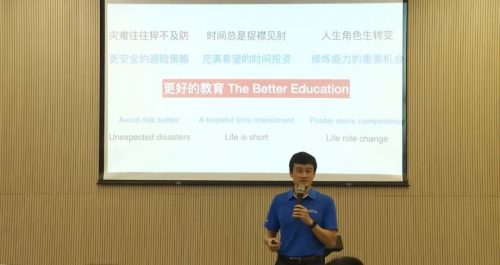
今年7月份,纽约时报发表了一篇文章,My Relatives in Wuhan Survived. My Uncle in New York Did Not.(《新冠疫情期间,我武汉的亲戚们安然无恙,我纽约的叔叔遇难了》)作者是饶毅,现任首都医科大学校长。

读到这篇文章时,我对于饶毅教授的损失感到非常的悲伤。在我的印象中,饶毅是一个非常乐观幽默的学者,2008年我在中科院研究生院参加“分子生物学和生物化学”学术夏令营活动,饶毅是讲师之一,他的讲座题目是《科学研究的动力》,他说动力来自三方面:好奇,敬业,求胜。
我同样认为这正是可以推动教师们对自己的教学工作精益求精的三个重要动力。好奇,让我们选择教育,敬业让我们站稳讲台,求胜——并非是要争取比别的老师教的更好,而是胜过自己——要比昨天的自己更好,不断发展,成为最好的自己,教有特色。
不知道在场有多少位老师知道Randy Pausch,或者看过他的《最后的演讲》(The Last Lecture)?

这个暑假,我重新看了这场演讲。Randy是美国卡耐基美隆大学(Carnegie Mellon University)的计算机科学教授,2006年他被诊断患有胰腺癌(pancreatic cancer),2007年8月,医生非常遗憾地告知他,留给他的时间还有3-6个月。一个月后,Randy登上讲台,进行“最后的演讲”。这是一场非常精彩的演讲,几天前,我在一个国际视频网站上看到,这场演讲的播放次数已经将近2千万次了。在演讲最后,他向全场观众说,其实今天这个演讲我不是给你们讲的,我是为我的孩子们讲的。Randy的三个孩子,当年分别是6岁、4岁和2岁。
假期中我的外祖母刚刚经历了一次与死神的搏斗,发病时她的心率一度不到每分钟20次。抢救之后,医生为她安装了人工心脏起搏器,现在她已经可以和我视频对话了。我的姥姥抚养长大了5个女儿,大女儿就是我的母亲。在姥姥病重之时,她非常恐惧,一直嘱咐身边的人,说一定要在最快时间见到我的母亲——她的大女儿。当我妈妈出现在病床前时,姥姥说:“你来了,我就安全了,我就不怕了。”
我姥姥出生在中国抗日战争时期。她见证了新中国的建立,经历了文化大革命,改革开放,走入了数码时代。中国在过去的几十年中经济快速发展,有些年轻和国外的老师们可能很难想象这个速度有多快。我的童年在北京度过,每周二晚上是没有电的,看书需要点蜡烛。一直到我上小学2年级之前,我和爸妈三人都是挤住在一间10平方米的房间中,使用公共卫生间,条件比我们学校的单身宿舍差的远了去了。
我姥姥有非常浓重的山东口音,我小的时候她从山东老家来北京看我,我们之间的语言沟通常会有问题。有一次,她做了汤给我喝,但因为是刚刚做好的汤,滚烫滚烫的,我喝了一口就向她吐舌头,她问我,怎么了——姥姥当时是用山东话问我:“咋了?”我说,烫!姥姥说,糖?因为山东话中“糖“发“去声“,她以为我想往汤里加白糖,就摇摇头说,“不中不中,喝汤哪有加糖的”。我就加强了音量,再次说:“烫!”姥姥这次抝我不过,就要起身去厨房拿白糖罐子,我更急了,吐着舌头说:“汤太热了。”这下姥姥终于是听明白了,“哦,你说热啊,来,俺给你吹吹”。当时的我怎么也想不到,有一天,曾经对童年的我予取予求的慈爱的姥姥,有一天也会像小孩子那样恐惧地需要子女们的依靠。
另外我们也还可以看到一件事情,我和姥姥都在用中文交流,但仅仅是音调的差异,就让我们的彼此理解出现了错位。这也是我们在未来领导力学校进行教学工作的挑战之一——多语言,多口音,多文化的环境,对教师语言运用的要求更高了。当教师在课堂中教学时,要根据学生的实际情况来选择适恰的语言。
我现在还记的那年在中科院的暑期学校中,身为分子神经生物学家的饶毅教授给我们做讲座时候的开场白,他说:“在过去的几年中,我们研究组一直密切关注着果蝇的色情与暴力。”那场演讲安排在下午第一节课,我正在昏昏欲睡中,一下子就被饶毅的这句话给刺激醒了,顺利听完了饶毅教授分享的他们研究组对于果蝇繁殖和竞争行为的研究成果及进展,至今记忆犹新。饶毅教授的第一本科普著作《饶议科学》出版后,我买来送给我的一个特别喜欢生物学的学生,孙同学,今年春节,我和孙同学在美国波士顿见面,当时由于新冠疫情我的回国班机被取消了,孙同学安慰我别慌,我可以暂住在他在剑桥的寓所中,这个时候的孙同学正在哈佛大学读神经科学的博士研究生。
Randy Pausch,他最后的演讲的题目是Really Achieving Your Childhood Dreams。Randy说,我们今天谈论的话题有关于我的童年梦想,启发他人去追梦,及我的一些人生教训。但我的演讲,不是告诉你去怎样实现梦想,而是你应该怎样生活。如果你以正确的方式活着,那么梦想终归会来找你的。换句话说,假使你不按照正确的方法活着,也许最后你只能按照你的活法想着。
2008年7月25日,Randy走到了他的生命尽头,比医生预测的时间长了5个月。在他生命之旅的最后一段,有的朋友鼓励他:“Randy,你赢了,你从死神手中争取了更多的时间。”Randy不假思索地回答朋友说:“我对赢了死神的判断标准,不是看活的是不是更长,而是要看活的是不是足够充分。死神终归要来,问题是我们在它来之前,要做些什么才算活得充分?”
今天距离Randy的最后演讲,已经过去12年了,看着自己的父亲《最后的演讲》视频长大的Randy的长子Dylan已经18岁了,今年他高中毕业,即将入读芝加哥大学。在他写给母校的感言中,他感谢了学校的课程对他逻辑思辨能力的培养。

通过饶毅、Randy和我姥姥这三个人的故事,我们看到了什么?
灾难往往猝不及防。时间总是捉襟见肘。人的一生,角色会发生转变。从出生时我们需要别人的照顾,到暮年时要别人来照顾我们。
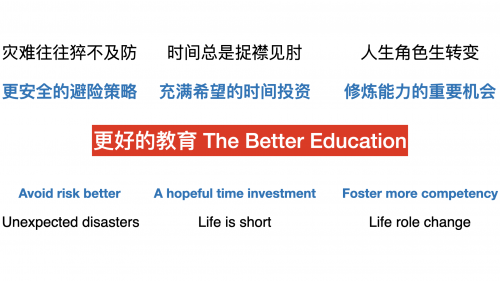
老师们想到了什么?我想到的是教育,好的教育是更安全的避险策略,是充满希望的时间投资,是你自己修炼能够照顾更多人的重要机会。 好的教育需要好的教师提供好的课程。在上学年正式评估课结束后,我和老师们分享过一个话题——人生,又少了40分钟。教师每节40分钟的课程,就是一段微缩的40分钟人生,不仅是自己,也是众多学生们的40分钟的人生。各位老师请扪心自问,您的这段人生,是不是像Randy说的那样,活的足够充分了?您的学生的这段人生,活的是否足够充分了?
我非常喜欢Peter, Paul and Mary乐队的一首歌,叫Puff, The Magic Dragon。对于这首歌,有多种角度的解释,我最喜欢的是直接从歌词的文本出发,把它当做童话来看。歌词写的是一条魔龙和一个小男孩的故事:魔龙和男孩是一对好朋友,他们常常在一起。有的时候他们乘坐鼓满风帆的船,男孩就坐在魔龙的尾巴上四处瞭望。王公贵族们见到他们,会脱帽致意,海盗船看到魔龙来了,也会偃旗息鼓……两个好朋友在一起,共度了很多美好的时光。魔龙其实是童年男孩想象出来的伙伴,当男孩长成男人,停止幻想,魔龙也就没有继续存在的必要了……沮丧魔龙回到了自己的洞里。但男孩成长过程中的这段时光,却会永恒存在。
我们的学生,从幼儿园升入小学,从小学升入中学,从中学升入大学,陪他们走过那些段永恒时光的老师,就像Puff这条魔龙……当我的学生们毕业了,我确实会有类似魔龙的那种失落……好在新的学期仍会开始,新的孩子Jackie还会到来。
给大家看看现实版的男孩儿Jackie和魔龙Puff。这两张照拍摄于12年前,分别是我和孙同学及巢同学的合影,他们当年是7年级新生,我是他们的班主任,正在他们家中进行家访。10年之后的又一个夏天,我们在美国马萨诸塞州的剑桥重聚,孙同学在哈佛读博士,巢同学在MIT读博士。刚才我提到今年年初,提出收留我的孙同学就是照片上这位。在现实中,魔龙Puff的生活还是要更幸福的。
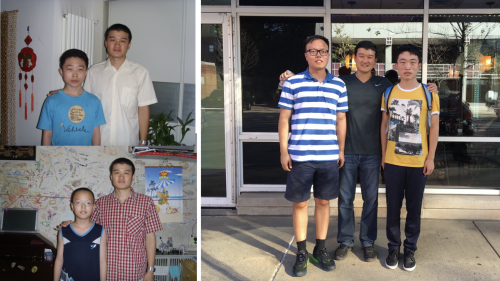
确实如此,我昨天和一名刚刚入职的新老师聊得特别开心。有两个原因:一个是他从美国顶尖的文理学院毕业后选择投身教育,第二个因为他曾是我教过的学生。昨天的小男孩Jackie,今天也变成了魔龙Puff,这不是让Puff更幸福的事情吗?希望我们的老师们,保持童心,保持激情。
我国宋人程颢的诗,用来描述理想的教师的这种可能比Puff, the magic dragon更合适:
云淡风轻近午天,随花伴柳过前川。
时人不识余心乐,将谓偷闲学少年。
新学期开始,祝愿老师们都有一个幸福的学期。
Read MorePD-我们现在怎样做教师?What kind of teachers should we try to be in digital era?
我们现在怎样做教师?What kind of teachers should we try to be now?
一百多年前鲁迅先生在《我们现在怎样做父亲》中写到:“自己背着因袭的重担,肩住了黑暗的闸门,放他们到宽阔光明的地方去;此后幸福的度日,合理的做人。”
40多年前。在俄勒冈州尤金市的一个后院烧烤会上,一群有远见的俄勒冈大学及当地K-12学校的教师们提出了一连串的问题……
如果我们给学生提供强大的工具,让他们学会自学,未来会怎么样?
如果我们让学生们并肩去解决他们心之所向的研究问题,未来会怎么样?
如果教师不说教,而是履行指导者和合作者的职责,未来会怎么样?
如果我们让计算机做它们最擅长的事情,把人们解放出来,去创造、去梦想、去改变世界,未来会怎么样?
这一连串的问题,孕育了国际教育技术协会International Society for Technology in Education(ISTE).(ISTE)的诞生。
我们是谁?
未来领导力学校的教师。
未来领导力学校的学生是谁?
未来引领者。
所以,我们是引领未来引领者的引领者。
现在,说的是我们所处的数码时代。
结合鲁迅先生的文章和ISTE诞生的故事,我今天想和各位分享:在数码时代,我们怎样做,可以引领未来引领者的引领者,放我们的学生到宽阔光明的地方去,用技术提升我们的工作效率和生活质量。
一、受众多
在刚刚过去的三周中,我代表学校在“快手”进行了三场直播,观看次数达到了104.7万。比我这辈子见过的活人数量还多,也远远超过我所教的学生总量。这确实逼迫我思考,我现在应该怎样做教师?原来1个小时的课,我需要准备5个小时,现在我需要准备15个小时。从现场拾音到OBS设置,从打光到滤镜设置,曾经做教师不必考虑的事情,现在都需要我搞定。
二、跨度广
课程研发工作的特殊性,需要我和全球多地的教师或机构协作。有的时候需要清晨开会,有的时候需要深夜讨论。昨天晚上9:40,我刚和位于纽约的伙伴完成了一个线上教学项目的准备工作。晚上11:30,我们完成课前讨论。生活在地球村的每一位老师,我们每一个人都可以借助工具,跨越时空。
三、钻研深
在线图书馆和搜索引擎的发展,让每一位老师做独立研究员,成为了可能。15年前我刚开始从事教师工作时,还要经常去国家图书馆检索资料,现在Google Scholar和Amazon已经在时效,体量和检索效率上更胜一筹。我和Spencer Burrows每周从中、美教育者的两个角度撰写的“批判性思维”系列文章的所有参考文献我都利用Zotero编整,并利用GoogleDoc同步写作。
四、目标准
FLA Line的第一名正式100%在线远程学习学生张同学目前以双学籍身份在佛罗里达学习生活。北京时间每周一的上午,我会利用Zoom给张同学进行同步教学,张同学在线下还要找出相应的时间进行独立学习。利用技术,我可以结合张同学的时间表,个人特点,进行“1对1”个性化的教学设计。目前各位老师在使用的SWIVL正式评估课录课设备也同样提供了精准性,大家每天的工作节奏都很快,每个人的时间表都特别满。不依赖工具,很难保障每一位课程评估人员都齐整地参与到了评估环节,很难保障评估结果的公正性。合理使用技术和工具,这些困难都迎刃而解了。
“君子性非异也,善假于物也。”希望在数码时代,每一位老师都可以做能够引领未来引领者的引领者,放我们的学生到宽阔光明的地方去,用技术提升我们的工作效率和生活质量。
更多资料,大家可以拿出手机,扫码下载。
What kind of teachers should we try to be in digital era?
More than a hundred years ago, Mr. Lu Xun wrote in “How do we be fathers now”: “Carry the burden of inheritance yourself, shoulder the gate of darkness, and let our kids go to a wide and bright place; thereafter spend their days happily and behave reasonably.”
More than 40 years ago. At a backyard barbecue in Eugene, Oregon, a tight-knit group of forward-thinking K-12 and University of Oregon educators began asking, “What if …?”
What if we gave students powerful tools allowing them to take charge of their learning?
What if we let students follow their passions and work with peers to solve problems?
What if teachers didn’t lecture, but served as guides and collaborators?
What if we let computers do what they do best, freeing up humans to create, to dream, to change the world?
That’s the story of the birth of International Society for Technology in Education(ISTE).
Who we are.
The teachers of the Future Leadership Academy.
Who are the students of the Future Leadership Academy?
Future Leaders.
So, we are the leaders of the future leaders.
Combining Mr. Lu Xun’s article and the story of the birth of ISTE, I would like to share with you today: in the digital era , how we can be leaders who can lead future leaders, release our students to a wide and bright place, and use technology and tools to improve our work efficiency and quality of life.
- More Learners
In the past three weeks, I represented FLA in three live streams on “Kuai Shou”, a shot video platform like TikTok developed by a Chinese company. with a total of 1,047,000 views. That’s more than the number of live people I’ve ever seen in my life, and far more than the total number of students I have taught. This really forced me to think about what kind of teachers should I try to be? Where I needed to prepare for 5 hours for a 1 hour class, I now need to prepare for 15 hours. From live sound pickup to OBS setup, from lighting to filter settings, things that I once didn’t have to think about as a teacher, I now need to take care of.
- Wider world
The traits of curriculum development work requires me to collaborate with teachers or institutions in multiple locations around the world. Some days require early morning meetings, and some days require late night discussions. Last night at 21:40pm I just finished preparing for an online orientation for am upcoming online project with my partner in New York. At 11:30,I finished the online discussion of the reflection of the online project. Every teacher living in the global village, every one of us can cross time and space with the help of tools and technologies.
- Easier Research
The development of online libraries and search engines have made it possible for every teacher to become an independent researcher. 15 years ago when I first started teaching, I had to go to the National Library to do research regularly, but now Google Scholar and Amazon have become more effective in terms of timeliness, volume and efficiency of retrieval. I use Zotero to compile all the references for the series of articles of “Critical Thinking” that Spencer Burrows and I write every week from both Chinese and American educators perspectives, and we use GoogleDoc to write them simultaneously.
- Less is more
FLA Line’s first official 100% online distance student, Zhang, is currently living and studying in Florida as a dual enrollment student. Every Monday morning in Beijing time, I will use Zoom to give Zhang synchronous teaching, and Zhang will manage her schedule to use more time offline to finish her independent study. Using the technology, I can personalize the “1-to-1” instructional design by taking into account Zhang’s schedule and personal characteristics. The SWIVL recording platform that the teachers have been using provides the same possibility, as everyone works at a fast pace every day and everyone’s schedule is particularly full. Without relying on tools, it is difficult to guarantee that every evaluator is involving in the evaluation session which may yield unfair results for teachers. Using technologies and tools wisely, these difficulties were solved.
“Talents of wise teachers have nothing different from others, but can take advantages of tools and technologies which are beneficial to them.” I hope that in the digital age, every teacher can be the leader who can lead the future leaders, release our students to a wide and bright place, and use tools and technologies to enhance our work efficiency and quality of life.
For more information, you can take out your phone and scan the code to download a document from ISTE.
Read MoreContemplating Chinese Speed and English Time 欲速则不达,中西无不同
段玉佩按:这是一篇写于2018年年底的文章,标题来自我的搭档,Dr. Brian O’Hare在工作中常常说的一句口头禅。现在看来,文中的内容我个人也觉得观点正确,值得在任何一个中西方兼容的工作环境中注意。敝帚自珍,立此存照。
Authors: Yupei Duan (Danny), Brian O’Hare
“Danny, you know, this is another ‘Chinese Speed versus English Time’ issue also…” were the words uttered to me by my coworker one day as we were planning our agenda for the week. Since Brian is the International Academic Dean at the Future Leadership Academy, I accepted his remarks just like he would accept some suggestions from me. Brian and I learn from each other and work together closely. The concepts of “Chinese speed and English time,” as he put it, were definitely good things to think about as an international team was forming. These words, I would later come to find out, have become a very important lesson for anyone working in a bilingual environment with two very different cultural approaches to time management.
Before starting my current position as the Chinese Academic Dean in FLA, for 10 years I worked in an elite high school in Beijing. When I worked as a subject teacher there, in my opinion, teachers on campus were just like soldiers on the front line of a conflict. They all needed to be given instant responses to spontaneous incidents so that they could be better prepared to fight to win. I was trained to finish preparing an excellent lesson plan with a well-organized PPT within 40 mins in my college. My education reinforced the notion that work was to be finished before the deadline. My mentor in college once told me, “If you have time for your meals, then you have time for your lesson plan.” It became one of my common habits that all assigned tasks should be finished ASAP, and that I should say “Yes, sir” to everything asked of me on campus just like on an army base. Because I grew up on an army base it was a natural response for me to obey orders without question. Now, however, I would like to reflect on this response after finishing one semester’s worth of work with many international colleagues. Is this truly necessary? What are the real reasons for such a short time for preparation? Are there any better and wiser solutions?
At the beginning of the first semester, I held a meeting with all of the parents, students, faculty and staff to introduce the schedules, after school programs, facilities, etc. At the same time, I had planned to ask subject teachers to present a brief introduction at the meeting. When I shared this idea with Brian, he suggested that I write requirement in an email and to distribute the proposal to all teachers ASAP to give them more time to prepare. I expressed how I did not think it was very hard to handle an introduction for a subject teacher, yet Brian reminded me that it would be more acceptable if teachers received tasks at least 24 hours in advance. It was not exactly clear what was asking of them last minute, which then turned into a conversation about what kinds of introductions we wanted them to present. Should these introductions focus on their classes or other academic requirements? Or should these be presentations about the teachers’ experiences in and out of the classroom? It became obvious that I did not think very carefully through all of the details. Later, we sent a message to describe all the details we wanted the teachers do, which led to a more effective and productive meeting in the long run.
Over the next few months, similar phenomena would happen. Gradually, I found a lot of advantages from jumping into something without thinking of all the possibilities more thoroughly. As a dean, I need to strategize ahead and think broader about certain topics than teachers and other staff. In this way, I must arrange plans and design blueprints ahead of department heads and coordinators. The more detailed the plans I have found, the better arrangement I can make for providing the best leadership and mentorship to all teachers. In hindsight, I would like to thank Brian who fist mentioned to me this notion of “Chinese speed versus English time”, which is clearly expressed by a Chinese idiom: More haste, less speed. (欲速则不达)
Unfortunately, being efficient cannot overstep the dignity deserving of all staff at FLA. For example, one night at an online meeting that included some administrators and myself, I had still wanted to express an idea when the meeting organizer abruptly ended the meeting by saying goodbye and hanging up the call. My sentence was interrupted and the meeting was finished, yet because I felt it was not right to occupy others’ time in such a manner, I could accept how the meeting ended. I personally believed that it was my fault for the curt behavior since I had extended the meeting time. The next morning, a colleague who attended that meeting told me that she felt sorry about how I was interrupted during my final statement. She did not think it was polite and wanted me to feel better about the situation. In actuality, I did not think anything was wrong at that time because of the idea of “Chinese speed” was one of my working philosophies already. Therefore, I could understand and accept this abrupt behavior. When another colleague found me to talk individually to explain his thoughts about that encounter, and then later, a third and fourth colleague came to comfort me separately, I began to realize something was amiss. Finally, I received a written apology from the meeting organizer. Several days later when we had another online meeting, he again apologized. These apologies left me confused again. Why would my international colleagues value their time and yet act differently when I had disregarded it? My understanding of “English time” with all of its rules and regulations is still something I am discovering the more I engage with the international staff.
In ending, I now understand that the school is more like a garden than a battle field. We need to be patient and detailed gardeners in order for the flowers and trees to grow. This requires us to nurture ideas, and take more time to make sure the quality of the word is not lost for the sake of speed. We do not have to be brave warriors who do know how to finish the work on time, but who do not know how to say “No” to decision-makers even if there are apparent flaws in their plans. As leaders, we need to keep the lines of communication open more, then we will be able to find out the real problems across various departments within the institution. By trying our best to avoid making mistakes, we can see the big picture when the problems regarding “speed” and “time” are really related to quantity versus quality. Before I became dean, I thought I partly understand this concept of “Chinese Speed versus English Time,” and I now know that I have a lot to learn from my international colleagues. The same goes for them as they learn to work in a different culture that sometimes moves at the speed of light, and I hope that we can learn to balance our quality of time and quantity of speed together.
好课之“好”
2007年9月4日上午,北京市西城区西黄城根北街,北京四中的多功能厅里,原本宽敞的大会议室,被几十个人挨挨挤挤地填充到显得局促,众人静静地倾听着会议室中间一位老人娓娓道来。有一句话,让当时在场的我至今仍记忆尤新——“学校代表着国家的未来”。讲话的人是中华人民共和国总理温家宝[1]。
2019年5月27日晚上,海南陵水清水湾大道,未来领导力学校的教师公寓中,我一边刷碗一边听手机中播放的央视“面对面”节目。“……因此我认为国家要充分看到这一点,国家的未来就是教育。”这句话让我停下刷碗的手,拿过手机仔细端详,屏幕上接受采访的这位75岁老人,是华为创始人任正非。
这两位政界和商界的领袖,对于“教育即未来”有着跨时空的共识。并不奇怪,无论是从经验来看,还是从理论出发,一个国家教育的发展都对本国的经济有着强大的促进作用。美国斯坦福大学胡佛研究所的高级研究员埃里克·哈努谢克(Eric. A Hanushek)和德国慕尼黑大学经济学教授卢德格尔·沃斯曼因(Ludger Woessmann)共同撰写的研究报告《经济发展中由学校革新带来的关键影响》The Role of School Improvement in Economic Development[2]不仅从国家教育实施的“量”上,还从“质”的层面上得出了教育革新对于国家经济发展的具体助益。他们以一个国家教育对于“认知能力培养的效果”作为指征,探索了它的提升对于国家GDP提高的强大推动性。
从上图中我们能看到,一个国家的教育,在保持每年投资(GDP的3.5%)不变的前提下对于“认知能力培养的效果”提升的越明显,这个国家在相应时间段内,GDP的提升也就更具优势。“如何把教育做的更对?如何把教育做的更好?”,在9年义务教育基本普及的中国是更急切的议题。这篇97页的报告不仅描绘了以国家和地区为单位的大教育促进经济发展的图景,还用详实的数据为每一个终生学习者重申了“书中自有黄金屋”这个亘古不变的真理。我们甚至可以对着研究报告的图表大声朗诵亚当斯密在《国富论》中的段落:“对于那些对熟练度和技能要求很高的岗位来说,一个花费大量人力和时间培育出来的人才,就相当于一台昂贵的机器。他所学会执行的工作,必须满足预期价值超出普通劳动力的一般工资,这样工作的价值将平衡他的教育花费,至少保证获得使用等值资本产生的正常利润……”这个来自两百多年前的论述,在如今这个“人工智能”的时代仍显得恰如其分。
Read More


